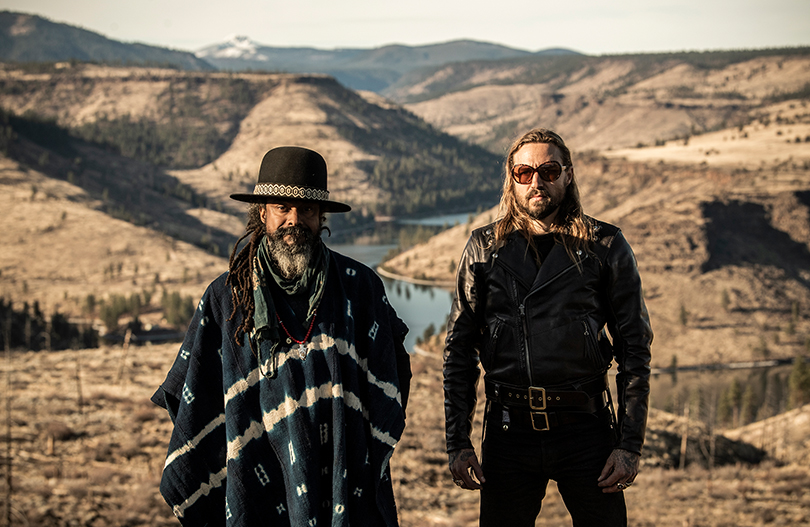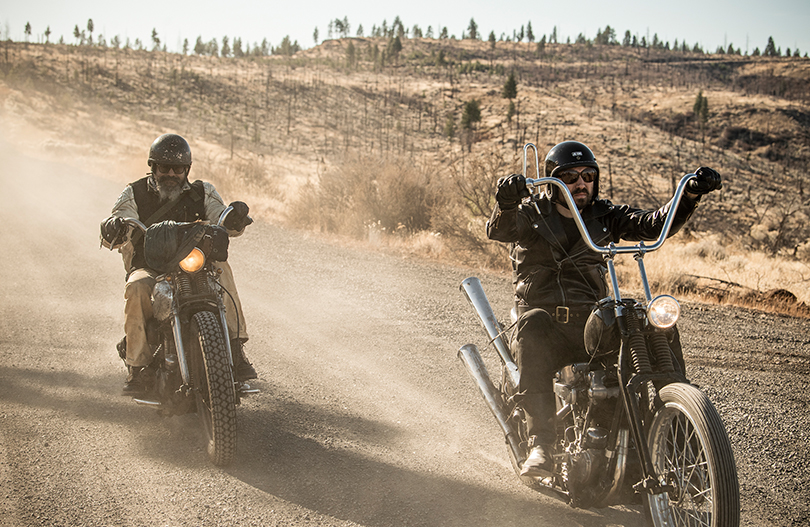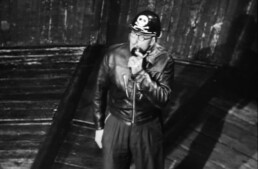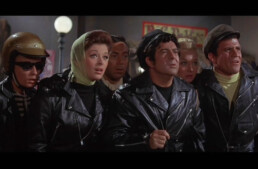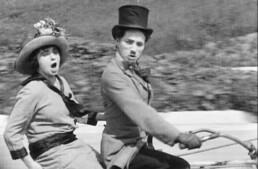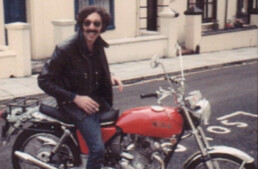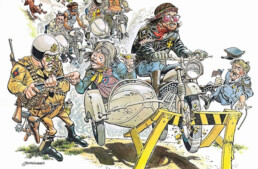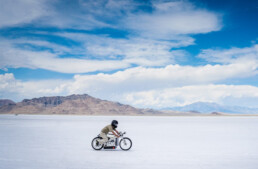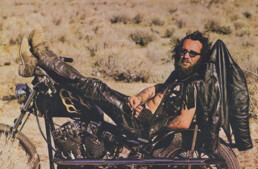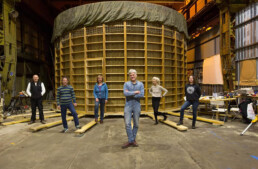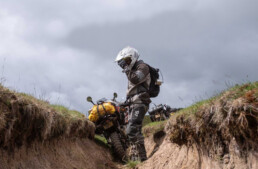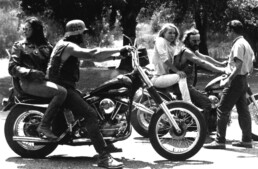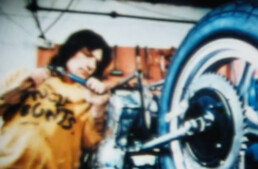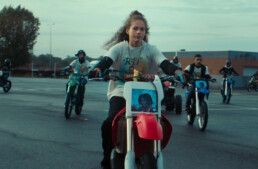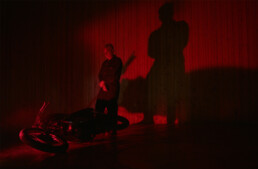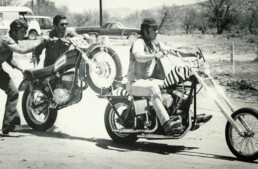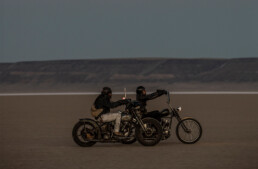The Vintagent Classics: Scotland Yard: The Wall Of Death
https://www.youtube.com/watch?v=c4rpIg8E9ck&feature=youtu.be
The Vintagent Classics: The films that inspired us.
SCOTLAND YARD, EPISODE #15: THE WALL OF DEATH (TV 1956)
Run Time: 30:00
Producer: Alec C. Snowden
Director: Montgomery Tully
Writer: Montgomery Tully, Judith Warden
Key Cast: Edgar Lustgarten, Cyril Chamberlain, Vernon Greeves
FILM MAKERS
Scotland Yard is a series of 39 half-hour episodes produced by Anglo-Amalgamated. Produced between 1953 and 1961, they are short films, originally made to support the main feature in a cinema double-bill. Each film focuses on a true crime case with names changed, and feature an introduction by the crime writer Edgar Lustgarten.
The earlier films were produced by Alec C. Snowden, who was succeeded by Jack Greenwood. Directors included Ken Hughes and Montgomery Tully. The principal character in each film is a Detective Inspector, played by a variety of actors but most frequently by Russell Napier (usually portraying DI Duggan). Many of the films feature, in supporting roles, actors later to become well-known. They include Jill Bennett, Peter Arne, Harry H. Corbett, James Villiers, Edward Judd, Arthur Lowe, Peter Halliday, Wilfrid Brambell, Rita Webb, Peter Bowles and Roger Delgado.
All of the episodes were shot at Merton Park Studios in London and on location on monochrome 35mm film. Most of the episodes were presented in the old Academy screen ratio of 1.33:1, whilst a handful of the later episodes were shot in a hard-matted widescreen ratio of 1.66:1
SUMMARY
A Scotland Yard detective investigates the death of a man who died on an amusement park ride.
The rider is Tornado Smith, riding his own wall at the Kursaal, Southend. Research continues into whether this episode was based on a true crime. Stay tuned!
RELATED MEDIA
Buy the complete series DVD Box set on Amazon
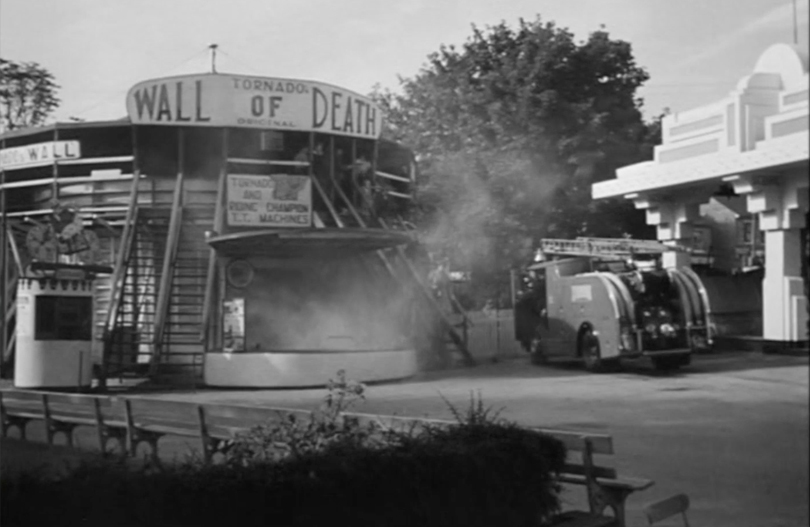
The Vintagent Classics: Beach Blanket Bingo
https://youtu.be/BEhnHynXa6w
The Vintagent Classics: The films that inspired us.
BEACH BLANKET BINGO (1965)
Run Time: 1:38:00
Producer: Alta Vista Productions
Director: William Asher
Writer: William Asher, Leo Townsend
Key Cast: Frankie Avalon, Annette Funicello, Deborah Walley
FILM MAKERS
"It's the wettest, wildest game in town!"
Beach Blanket Bingo is a 1965 American beach party film directed by William Asher. It is the fifth film in the Beach Party film series. The film stars Frankie Avalon, Annette Funicello, Linda Evans, Deborah Walley, Paul Lynde, and Don Rickles. Earl Wilson and Buster Keaton appear. Evans's singing voice was dubbed by Jackie Ward.
The story involves a missing pop star, a mermaid, and Eric Von Zipper's gang. Timothy Carey is wild as zonked-out hipster South Dakota Slim, a pool playing, biker sadist, and kidnapping tap dancer who is a swell guy.
The Hondels rock on "The Cycle Set." Tons of other songs are performed by Frankie, Annette, Donna Loren and Linda Evans. Frankie Avalon, Linda Evans, Annette Funicello, Deborah Walley, Harvey Lembeck, John Ashley, Jody McCrea, Donna Loren, Marta Kristen, Timothy Carey, Don Rickles, Paul Lynde, Bobbi Shaw, Buster Keaton, Brian Wilson, The Hondels.
SUMMARY
A singer, Sugar Kane (Linda Evans), is unwittingly being used for publicity stunts for her latest album by her agent (Paul Lynde), for example, faking a skydiving stunt, actually performed by Bonnie (Deborah Walley).
Meanwhile, Frankie (Frankie Avalon), duped into thinking he rescued Sugar Kane, takes up skydiving at Bonnie's prompting; she secretly wants to make her boyfriend Steve (John Ashley) jealous. This prompts Dee Dee (Annette Funicello) to also try free-falling. Eric Von Zipper (Harvey Lembeck) and his Rat Pack bikers also show up, with Von Zipper falling madly in love with Sugar Kane. Meanwhile, Bonehead (Jody McCrea) falls in love with a mermaid named Lorelei (Marta Kristen).
Eventually, Von Zipper "puts the snatch" on Sugar Kane, and in a Perils of Pauline-like twist, the evil South Dakota Slim (Timothy Carey) kidnaps Sugar and ties her to a buzz-saw.
RELATED MEDIA
Watch the FULL FILM on Amazon
Buy the DVD at Video Beat
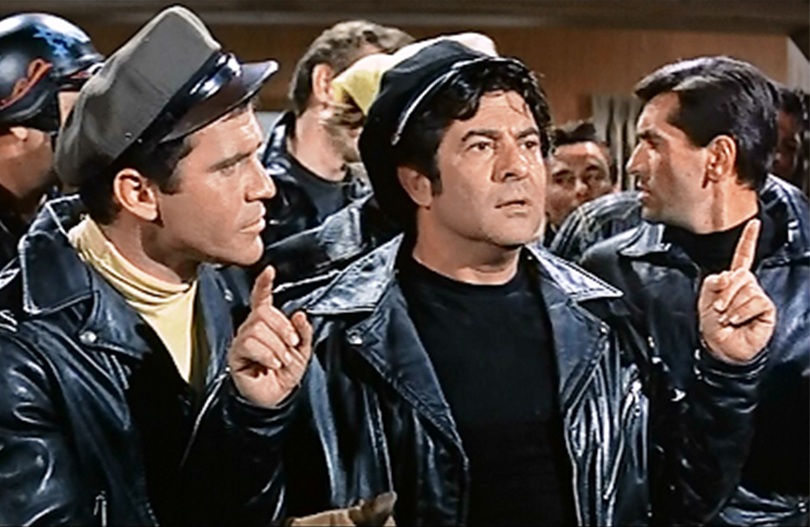
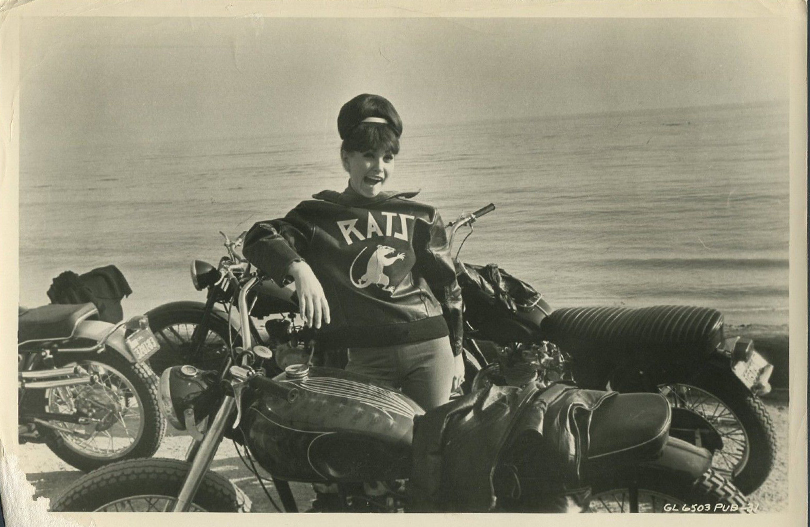
The Vintagent Trailers: We Ride
https://vimeo.com/842904942?share=copy
The Vintagent Trailers: A preview of our favorite feature films out there.
WE RIDE (2022)
Run Time: 14:00
A Film By: Romain Thomassin
Editor: Angelita Mendoza
Key Cast: Jane Love, Agata Dabkowska, Lanakila MacNaughton
FILM MAKERS
Romain is a French director and producer living in San Francisco. He started his filmmaking career in Brooklyn where, for 10 years, he shaped a keen eye for subcultural movements and authentic human stories inspired by artists, musicians and designers for whom he directed film portraits, short docs and music videos. While in Brooklyn, Romain also worked at Vice Media for four years, where he developed a raw, visceral yet entertaining approach of storytelling and learned a motto that he often makes his own: "make serious stupid, make stupid serious". Amongst multiple Vice projects Romain wrote and creative-directed Encore: a Never-Ending Story, a short doc about the history of the encore tradition at music shows (feat. Dolly Parton, Har Mar Superstar, Grouplove, Mac DeMarco, Michael Stipe and many others). He also co-wrote, along with director Laura Herrero Garvín, the short film Borrando la Frontera following contemporary artist Ana Teresa Fernández "erasing" the U.S.-Mexican border wall. The film premiered at the Hot Springs Documentary Film Festival in 2018. In 2019, Romain founded Saturated, a Brooklyn and SF-based production company focusing on nonfiction cinema, social media videos and branded content. Saturated produced videos for Parrot Drones, New York Fashion Week, IDEO, WantedDesign, Jellysmack and French Embassy’s artist residency: Villa Albertine. Romain’s latest short film We Ride, draws a parallel between Hunter S. Thompson’s Hells Angels and a new generation of women motorcyclists. It premiered at the Hot Docs Canadian International Documentary Festival in May 2023.
We Ride will be releases for view online in 2024. Stay Tuned!
SUMMARY
Gonzo journalist Hunter S. Thompson's Hell's Angels is given new meaning when compared, contrasted and appropriated to describe the hell-raising antics of groups of fierce and free-wheeling women who hit the road on their own custom bikes and their own terms.
Motorcycles have long been considered the property of men. Amongst them: the outlaws from the Motorcycle Clubs, once described with surgical precision by gonzo journalist Hunter S. Thompson in his first book: Hell’s Angels (1967). But a new generation of women riders is hitting the road, low in the saddle of the Harley choppers. Fueled by a passion for speed and mechanics, they created riding collectives, motorcycle camps, clothing brands, custom shops and garages... embracing the codes of iconic biker culture but also revolutionizing it from within. From the streets of New York to the pine forests of Oregon, they transform the horsepower of their engine into a force for personal empowerment. Juxtaposing Hunter S. Thompson’s writings about male biker gangs in the 60s, with contemporary stories of women motorcyclists, We Ride questions the persistent stereotypes in motorcycle culture, ultimately proving that riding has no genre. “Ah, these righteous dudes, they love to screw it on..."
*'We Ride' was granted the rights to use Hunter S. Thompson's cult classic Hell's Angels: The Strange and Terrible Saga of the Outlaw Motorcycle Gangs (Ballantine, 1967) by his estate and his wife Anita, who created the Gonzo Foundation dedicated to promote literature, journalism and political activism through the legacy of Hunter S. Thompson.
RELATED MEDIA
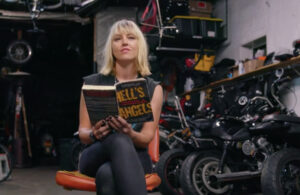
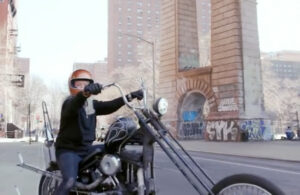
The Vintagent Classics: Mabel At The Wheel
https://www.youtube.com/watch?v=GUsYq2MbFOI&t=3s
The Vintagent Classics: The films that inspired us.
MABEL AT THE WHEEL (1914)
Run Time: 23:22
Producer: Keystone Film Company
Director: Mabel Normand, Mack Sennett
Writer: Charles Chaplin
Key Cast: Charles Chaplin, Mabel Normand, Harry McCoy
FILM MAKERS
Mabel at the Wheel is a 1914 Keystone Studios slapstick comedy produced by Mack Sennett, written and directed by Mabel Normand. It was the first two-reel film starring Charlie Chaplin (credited as Charles Chaplin)
The Keystone Comedy Studio was built on nonsense and slapstick, a product of the fertile, perhaps warped, mind of Mack Sennett. How curious, then, to think that the foundation of Keystone’s success was a small dramatic actress by the name of Mabel Normand. Mack, and his partners, promised her dramatically-oriented comedies to match her classical training. While many of her films with Keystone were slapstick, her main job was to create what Chaplin called the 'pulchritudinous influence', which would afford balance to the otherwise zany pictures. Until Mabel, Keystone films had merely been situation comedies, but Mabel took the studio further, crafting equal parts drama and comedy into complex and endearing story lines.
SUMMARY
Chaplin plays a villain, a Dutch immigrant (a character made famous by Ford Sterling, the star of Keystone, whom Chaplin had been asked to replace... and imitate, which he would not tolerate for long). Mabel Normand, meanwhile, is the girlfriend of a pilot (Harry McCoy). On the occasion of the Vanderbilt Cup, a famous car race which takes place in Santa Monica, Chaplin kidnaps Mabel's boyfriend to prevent him from participating in the competition. But Mabel is not discouraged and gets into the car herself. In spite of all the attempts of sabotage of the perfidious little mustachian, she will manage to gain the final victory.
The story goes that Sennett asked Chaplin if he’d ever ridden a motorcycle, to which he answered “yes”, but it turned out he’d only ever ridden a pedal cycle. They began to shoot the scene where Chaplin takes Mabel for a ride on his motorcycle. Charlie was sitting on the 1912 Thor chain drive Model M Type IV , and Mabel climbed on. Charlie pushed off, the motor fired, Charlie gave it full throttle and the machine roared off. However, they’d only gone five yards before the thing went into a huge wobble. After a few high-speed seconds, Mabel was thrown from the bike, and cast unceremoniously into a ditch, in a flurry of Parisian petticoats. They later pried Charlie from among the wreckage of the cycle... - The making of Mabel At The Wheel
RELATED MEDIA
The making of Mabel At The Wheel
The life and times of Mabel Normand
Mabel, a motorcycle girl
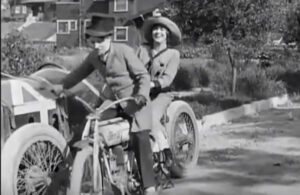
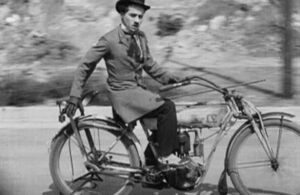
The Vintagent Selects: Norton Commando at 50
https://vimeo.com/303847065
The Vintagent Selects: A collection of our favorite films by artists around the world.
NORTON COMMANDO AT 50 (2018)
Run Time: 8:00
A Film By: Roberto Serrini
Key Cast: Allan Tannenbaum, Kenny Cummings, Elspeth Beard
FILM MAKERS
Roberto Serrini has many credits and awards under his belt. Including a handful of motorcycle films including Earned: The Story Of Keith Hale's Ducati 750SS (2021, All The Pretty Things (2021), The American Wall Of Death (2016), and Moto Borgotaro (2015).
SUMMARY
The Norton Commando motorcycle was first produced in 1968 and Brooklyn's Union Garage and the UK's Belstaff celebrated the anniversary in style. This film gives a look into some of the characters of the NYC motorcycle scene and an homage to an English tradition and "the cutest version of an American chopper you've ever seen."
RELATED MEDIA
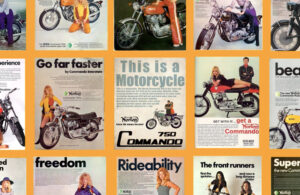
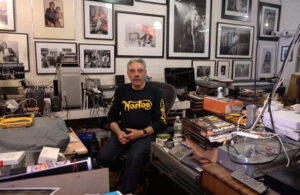
The Vintagent Classics: The Pink Angels
https://youtu.be/iKbY6UCFXzY
The Vintagent Classics: The films that inspired us.
THE PINK ANGELS (1971)
Run Time: 1:21:00
Producer: Plateau Productions
Director: Larry G. Brown
Writer: Margaret McPherson
Key Cast: John Alderman, Tom Basham, Henry Olek
FILM MAKERS
The Pink Angels is an oddball exploitation film written by a woman (with no other credits to her name), and is the only film in the American Biker Flick genre (1966-1972) to focus on a non binary motorcycle gang. A campy romp full of one liners on sexuality, mixed with a dark undercurrent that hits heavy on the anti-establishment, anti-Vietnam politics of the time, culminating in a shocking final scene. see summary for details.
SUMMARY
The Pink Angels frolic up the California coastline, on their way to a "ladies Cotillion (drag queen contest) in L.A. Meanwhile, quick cuts jump to a nameless, maniacal military general who's hell-bent on locating and capturing all “long hairs” on a top secret map. Targeting biker gangs specifically, 'The General' much like Uncle Victor in Harold and Maude, is made to seem foolish. Stuck in a brutal, bloody past which the hippy generation has moved beyond.
In the final scenes, the Pink Angels dressed entirely in drag, meet a rival gang who don't recognize “the broads” as their sworn enemies, and instead, ask them out. They load the ladies onto the backs of their bikes and head to a party, but the military is waiting, and everyone's hauled in for questioning. The General probes the “gals” for incriminating dirt on the bikers, but the Pink Angels refuse to bad mouth the gang even though they are sworn rivals. In an act of biker comradery, They voluntarily reveal that they are not girls at all…but bikers themselves…"cross dressing, biker faggots!"
One final jump cut shows a shocking end. The Pink Angels hanging from a tree. Lynched not for being bikers, but for cross dressing. An end even too brutal for The General to inflict on the bikers he was mercilessly hunting, while God Bless America plays and the credits roll.
Followers of gay cinema of the 20th century will recognize this end as all too familiar. scenes of queer characters meeting tragic and violent ends was used for decades following the Hays code to depict gay characters as deviant, thus making their violent death a moral warning. Watch 'The Celluloid Closet' for a great primer on this subject.
RELATED MEDIA
Read more at Cine Meccanica
Buy the film at The Video Beat
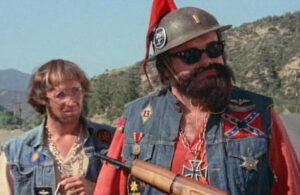
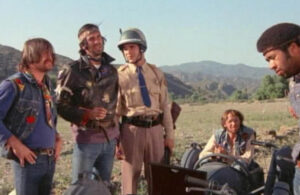
The Vintagent Selects: Salt Fever
https://www.youtube.com/watch?v=kvl5-xhiEcg
The Vintagent Selects: A collection of our favorite films by artists around the world.
SALT FEVER (2015)
Run Time: 18:27
A Film By: Minnie Freudenthal & Manual Rosario
Narration: Minnie Freudenthal
Key Cast: The Racers Of Bonneville
FILM MAKERS
Salt Fever was screened on September 26, 2015, at the Motorcycle Film Festival, in Brooklyn and in June 2016, it was chosen to open the Lisbon Motorcycle Film Fest at Cinema São Jorge, in Lisbon.
When we are editing a film we end up looking at it and revisiting it without counting, always on a small screen.
We know the smallest details not only two clips and also the multiple layers of the sound trail. With each visualization we always find something to improve… More to see the film that we made on a cinema screen, in a dark room, surrounded by dozens of people, feeling them react and finally hearing the applause is a very strong and unique experience that I confess I never expected to live... - Manual Rosario
SUMMARY
Our curiosities brought us to the BUB Motorcycle Speed Trials and what we saw was terrifying…
Documentary about the 2013 BUB at Bonneville Salt Flats by Manuel Rosario and Minnie Freudenthal. This documentary is about the people that come to this event, the sharing of creative solutions, women's participation and the general warm feeling at the BUB.
The finish line was not the starting point. Therefore, the result was so surprising.
When I asked myself: “how are we going to see the specks in Bonneville? I am certain that my eyes will show fright.
I walk around in the environment, feeling dizzy in my body with the illusion that it's snowing, it makes me insecure about being able to film the specks and talk with people about a matter I know little about. I've been riding moped for more than 40 years, but I don't know anything about engines, brands or even to recognize that it was modified for better performance. For that, I could count on my husband! The map that they give us when we buy the entrance tickets does not let us imagine that the environment is open, cordial and close. Let's go back to beautiful images and conversations with people from many places and professions. For 1 year, we ride with that material. At the finish line, it wasn't all our dreams and that's why we were so surprised! - Minnie Freudenthal
RELATED MEDIA

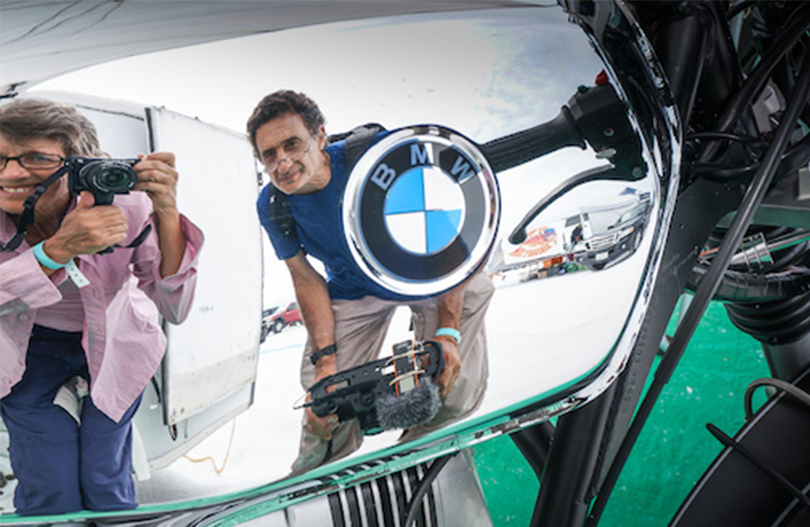
The Vintagent Classics: Hell's Angels '69
https://youtu.be/8d7VanlMb2I
The Vintagent Classics: The films that inspired us.
HELL'S ANGELS '69 (1969)
Run Time: 1:37:00
Producer: American Internation Pictures (AIP)
Director: Lee Madden
Writer: Don Tait, Tom Stern, Jeremy Slate
Key Cast: Tom Stern, Jeremy Slate, Conny Van Dyke
FILM MAKERS
It’s gonna be a mindbender. An upper to end all uppers
Roger Greenspun of The New York Times wrote in his review: "HELL'S ANGELS '69, which opened about 30 per cent out of focus at the DeMille yesterday, uses that noted law-and-order group, the Oakland Hell's Angels, as heroes in a dismal story that wastes most of its attention on the villains. By now their physical resemblance to lovable teddy bears may well have affected the Angels' self image, but not, I hope, to the extent that they continue to submit to such degrading elevation in American folk-demonology. Two California playboy types (Tom Stern and Jeremy Slate, who also wrote the film in which they star) join the Angels and con them into riding to Las Vegas, where they use them as public diversion to cover a robbery from Caesars Palace.
They make their haul, and their getaway, but not without the encumbrance of a buxom Angel mamma (Conny Van Dyke) and the threat of the Angels' revenge. Revenge comes after a desert motorcycle chase, photographed with such concern for getting pursuers and pursued into a single frame that it looks less like a chase than a pleasure ride. Before the Angels have brutally righted the wrong, the Nevada desert has been covered with a quantity of lost loot perhaps unequaled since the windblown paper money finale of Allan Dwan's The River's Edge (1957). But comparisons can only hurt Hell's Angels '69, which more than lacks in character and conviction what it attempts to make up in sucker's-eye views of Vegas casinos and timid glances at bike-groups' mores. With this caper, as with so many in recent movies, the theft is for a lark rather than for the money — a squandering of time and energy (more time than energy) that seems both unaesthetic and immoral. Only Miss Van Dyke emerges, her acting ability still in question (a plus in the context of Hell's Angels '69), but her physical presence superb. Plump, pretty, with a kind of facial nobility that depends more on soul than on bone structure, she catches the image of the American lost girl with an indirection that deserves a better movie than this."
SUMMARY
This was the RUMBLE that ROCKED Las Vegas!
Two brothers, Chuck and Wes, plan to rob the Caesar's Palace Casino in Las Vegas, Nevada. They decide to use the Oakland Hell's Angels as dupes in their plans by pretending to be members of an East Coast motorcycle club/gang and winning the Angels' trust, and then using them to create a disturbance outside the casino while they are inside robbing it. While gaining the trust of the Angels, Wes becomes romantically involved with Betsy, one of the Angels' "old ladies" who has a rocky relationship with the Angel Tramp.
Chuck and Wes's plan to rob Caesar's Palace first involves them persuading the Angels to make a weekend run to Las Vegas, where the Angels occupy a farm just outside of town belonging to the sister of one the club members. Chuck and Wes make a bet with the Angels that they can go directly to Caesar's Palace, in spite of their shabby biker appearances, to both gamble and rent a hotel room. Betsy asks the brothers to take her into town with them, but they leave her behind, after which she decides to hitchhike into town to join up with them. Once inside Las Vegas, the brothers stop at a bus terminal mail stop and pick up a set of dress suits they had shipped to themselves in advance of the planned robbery.
Chuck and Wes check into a reserved room at Caesar's Palace wearing their biker garb. They then make a phone call to the farm where the Angels are camping, feigning harassment in the hotel for being bikers, asking for the club to come into town to back them up. With the bikers en route to the hotel, they quickly change into their suits and a more "square" appearance. They enter the casino and use the pretense of one of them having a stolen credit card and being detained by casino security as a means by which to gain access to the cash cage, whilst outside the Hell's Angels arrive, squaring off against casino security and the police, demanding entrance to the casino while Chuck and Wes return to their room (and are witnessed doing so by the just-arrived Betsy), change back into their biker garb, and leave the hotel with $600,000 in stolen cash, unbeknownst to both the Angels and law enforcement, who are looking for two suspects in suits instead of two bikers.
Once camping back outside of Las Vegas, the Angels expel Chuck, Wes, and Betsy from the group for wasting their time over coming into Las Vegas over far less apparent trouble than they purported to be having. The trio exchange their choppers for smaller scrambler motorcycles and plan to cross the open desert to make their way back toward Los Angeles. Shortly afterward, the local sheriff pays a visit to the Hell's Angels and relays his suspicions that the robbery may have been carried out by Chuck and Wes, who in turn were playing the Angels this whole time. The Angels plan to track down Chuck and Wes, locating the motorcycle shop where they also obtain scramblers and pursue the brothers and Betsy out into the desert.
It becomes revealed that Chuck and Wes are in fact half-brothers, and that neither of them needed the money from the robbery because they live off of a sizable inheritance which is solely in Chuck's name. The robbery was carried out simply for the thrill of it with the intention of returning the entire stolen sum once the brothers have returned to their home in Los Angeles. Wes, however, becomes resentful at the idea of continually depending on Chuck for his livelihood and decides to keep half of the money stolen from Caesar's Palace. They fight, with Wes and Betsy splitting off from Chuck. The Angels arrive and see that the trio has split up. They ride after Chuck on a prolonged motorcycle chase. Chuck is nearly trapped, and attempts to jump his bike across a gorge to get away from being surrounded by the Angels. Chuck jumps short, his bike explodes on the other side of the gorge and he is killed.
Wes and Betsy arrive just in time to see Chuck die, after which they are surrounded by the Angels, who take the stolen money, disable Wes and Betsy's motorcycles, and dump out their water supply. The Angels ride off as Wes and Betsy abandon their now useless motorcycles and are left to an uncertain fate as the movie ends.
The movie is noteworthy for having many prominent members of the Hells Angels (most notably Sonny Barger) play themselves.
RELATED MEDIA
Read more at Cine Meccanica
Watch the FULL FILM
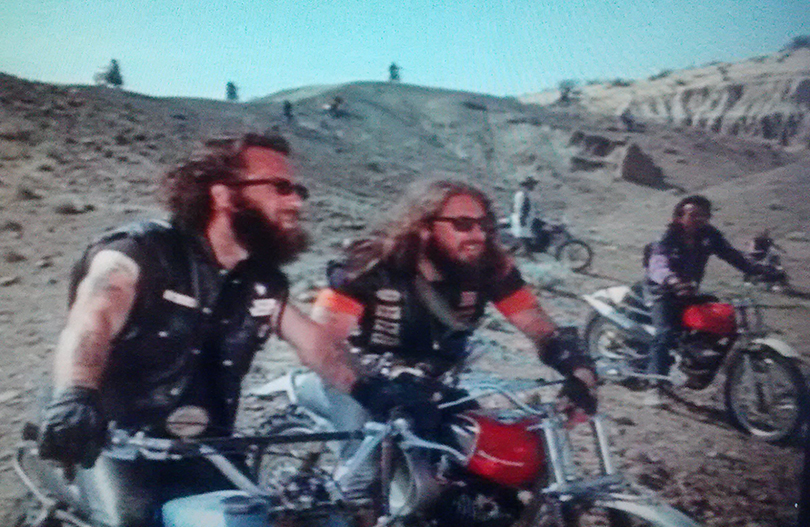
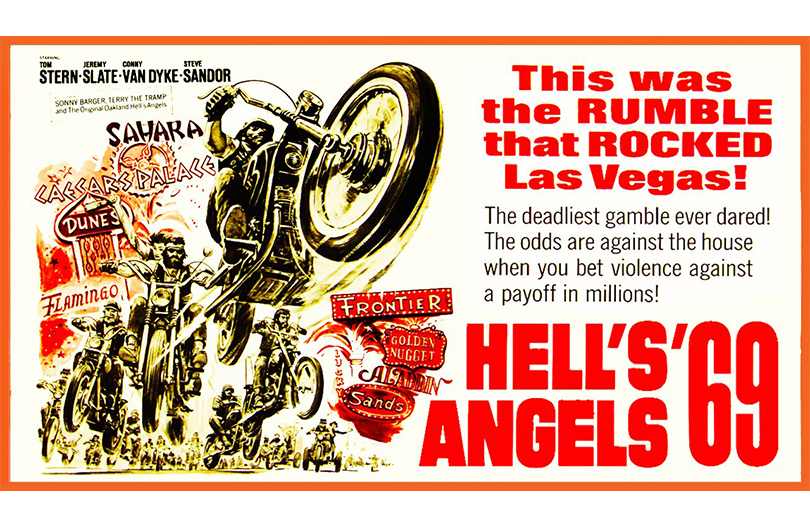
The Artist And The Wall Of Death
In March we featured the trailer for the feature length documentary, The Artist and The Wall Of Death (2023), directed by Maurice O’Brien. The film follows Stephen Skrynka's five-year obsession to build his own Motordrome, and learn to ride it. In the film, we quickly discover that Stephen is as unique as his project, and while building a Wall of Death proves an epic struggle, he is rightly the center of this fascinating story. He embarks on his journey via two friends who built a Wall in their backyard (and on whose story became the 1986 film Eat The Peach), but Stephen’s journey has its own twist, with the Wall he constructs becoming a detailed work of art itself that evolves into a vibrant art space.
The Artist And The Wall Of Death is now available worldwide to screen on iTunes. Watch it HERE. To celebrate its release, we caught up with the Artist in the interview below.
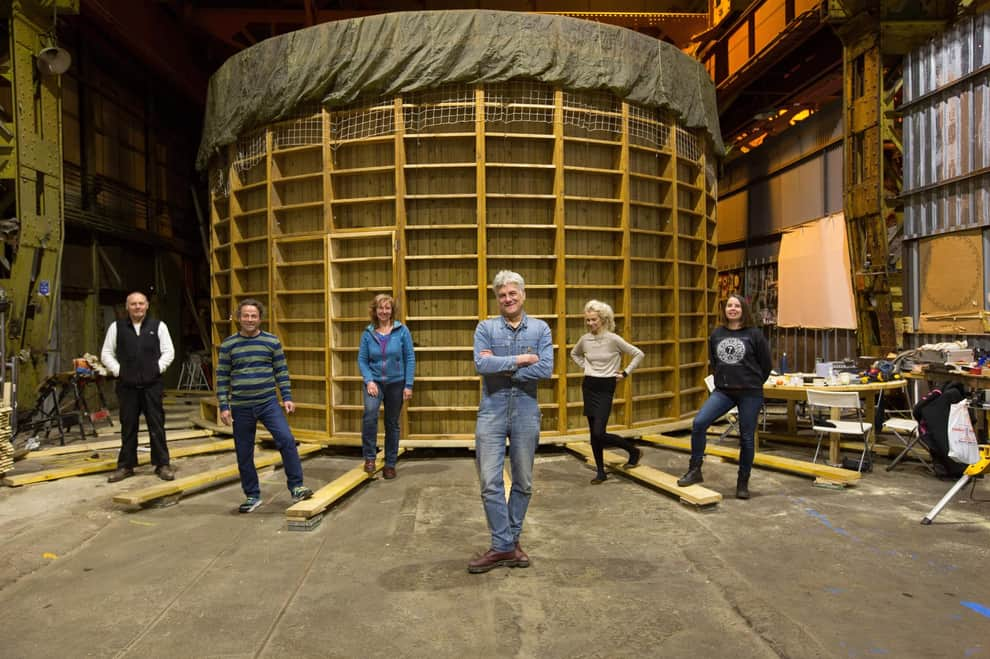
Stephen Skrynka (center) and several players in his artistic cohort. [Robert Perry for The Scotsman]
Stephen Skrynka
“It’s the nearest thing to being alive” - Richard Thompson
I began to construct the wall in the first week of lockdown in my shed. Luckily I had enough wood stockpiled to get me started. I worked in total isolation under no illusion about the size of the task but I realized that if I did not start, I would never start. I had no idea if or when I would finish this mammoth task. “Start a huge, foolish project, like Noah. It makes absolutely no difference what people think of you.” (Rumi) I originally trained as a cabinetmaker so it was important for me to build it to the best of my ability using only traditional woodworking joints such as mortise and tenons, dado housings and finger joints….and no nails, in the traditional manner of a Japanese temple building. By its nature, this challenge created a thing of great beauty and great strength. There were no drawings, everything was worked out live. I worked like this from March until August, day and night. When I outgrew my shed I spilled out into the garden.
Then the lockdown eased and I was able to move all the work into a shipyard on the Clyde called Barclay Curle in Whiteinch, Glasgow. I phoned a number painted on the side of the building that said space was available. By sheer good fortune, Bradley, the owner of the building is from a Fairground family and believed in the project. He and the buildings co-owner Andrew offered me the space to carry on with the work for free and without their generosity and support there is no way I could’ve carried on. Thereafter, I was joined by a group of people who wanted to help. They were curious and could see the level of devotion that was required to make this thing real. The word was out, volunteers appeared one by one and before too long we were a dedicated group of mavericks, comrades from all walks of life, all learning from each other and spurred on by the vision. It gave us all a sense of purpose and a routine during very difficult and dark times. In total we have spent over 14,000 hours building this using hand tools.
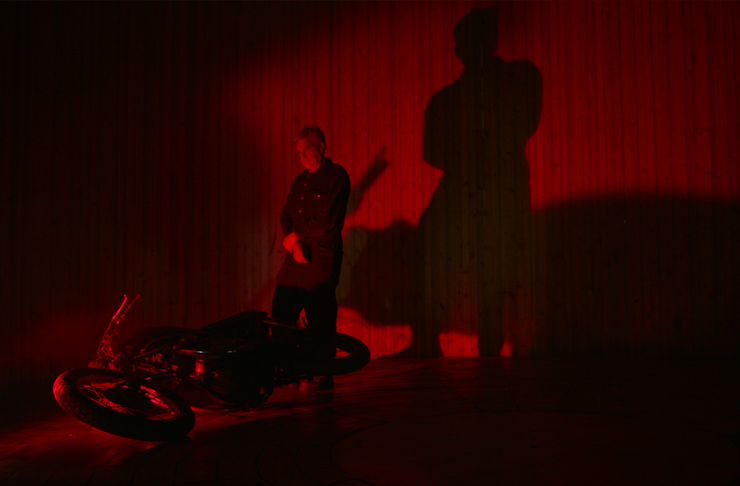
Soon we ran out of wood. People we didn’t know started to give us money, mainly modest amounts of money, £20 here, £50 there, then somebody anonymously put an envelope with £500 through my door with a note saying keep up the good work. Everybody started believing in what we were doing. It was like a miracle. In this way we carried on until we were finished. The whole project I see as a work of art in itself. It is impossible to put a cost on something like this. It is priceless because it is beyond being quantified in financial terms. This has made us free from the pressure of the corporate world, it has enabled us to use the space in very interesting ways. We have had cinema screenings by independent filmmakers, plays, concerts, art exhibitions plus fundraising events for Ukraine (I rode the wall and did 109 as a fundraiser). My father was a Ukrainian refugee from the Second World War.
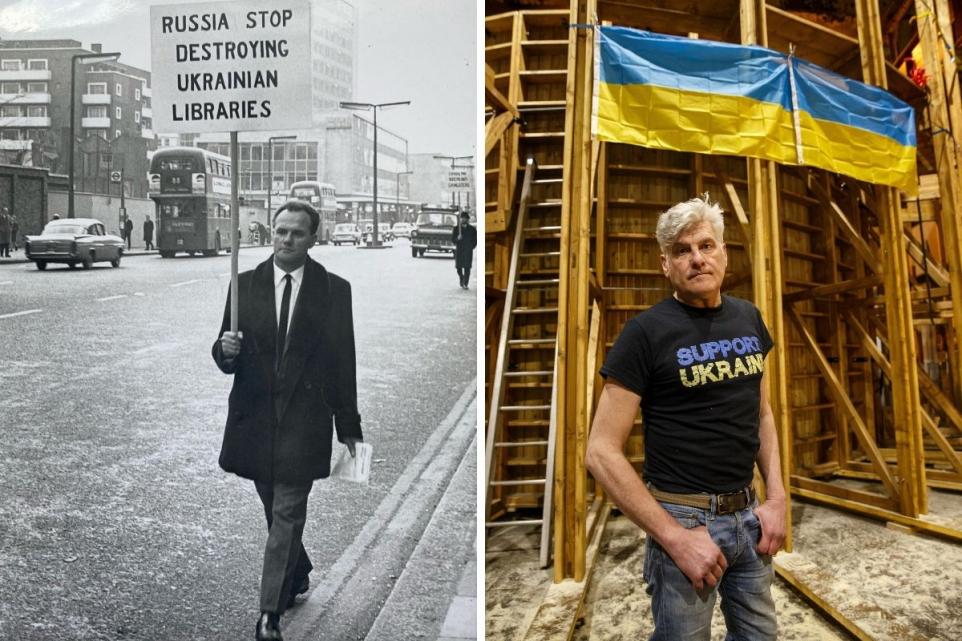
Artist Stephen Skrynka and his late father Volodymyr, protesting at the Russian Embassy in London in the 1960s. [Colin Mearns for The Herald Scotland]
I am very lucky that I was taught to learn to ride by Ken Fox about 15 years ago and grateful that he took me on. I was, without a doubt, the world’s worst and most accident-prone apprentice. I found it so difficult to get the hang of. Eventually I managed it but not without many accidents. It is the strangest feeling of exhilaration, living on a knife edge, poised between serenity and oblivion. I can only ride…doing actual tricks is a whole other ball game. If you see a professional Wall Of Death trick-rider it takes it all to another level. Through years of experience they somehow manage to make it look so easy.
My children have been very supportive and I think if you asked them they would probably say they’re quite proud of me. If they were worried for me, they hid it very well.
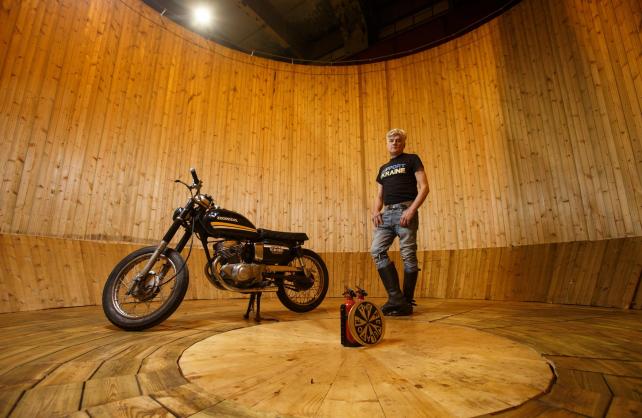
Stephen with one of his stripped-down Wall bikes. [Colin Mearns for The Herald Scotland]
For £3.50 you can watch three people risk their lives for 15 minutes in front of your very eyes as part of a Fairground Attraction which goes back 100 years. To quote Richard Thompson “it’s the nearest thing to being alive.” I believe that art should always in some way reflect life and death, to me that is its very purpose. So in my opinion, the Wall of Death isn’t just a Fairground Attraction but actually a pure form of art. An art form which is choreographed and balletic, an art form which has not changed in 100 years and yet still affects people as deeply as it ever did. The majestic skill and daring required is difficult to take in when you see it performed before your very eyes. As a spectator you are very much part of it and being at the top looking down you are making an implicit pact with danger. It is magical realism in the true sense and so visceral, I have seen at least five people in the audience faint.
The Wall Of Death riders I have met are made of something very special, their total commitment goes beyond their bravery and riding skills, it is actually a way of life, a hard life on the road. People sometimes imagine that these are superstars that just turn up in a limo to perform and then disappear to their hotel rooms. Reality could not be further from the truth, they have to know how to load up, build up the wall, pull it down, drive the lorries, see to all the mechanics and meticulously maintain their 100 year old motorcycles which they depend on with their lives … and all done on a shoestring. It takes grueling stamina and determination to do this season after season.
Part of the magic of the Wall of Death is it seems to appear in a community as if by magic, it’s there for a day or two and then disappears; almost like a dream, you are left wondering whether you actually imagined it all. There are few Walls left in the world, quite a dwindling number and yet in our digital age It is unique to be confronted by something so powerfully real. I think it is so important to keep this tradition alive.
As an artist my interests are twofold, the first, as I mentioned, is to keep the tradition alive and the second is to celebrate the Wall Of Death as an Artspace in and of itself. The Wall of Death I see as an archetypal architectural space which has resonance with the Brochs of Scotland (stone circular buildings from 300 BC) Jeremy Bentham’s Panopticon, the Trulli of Apullia in Italy, the Pantheon in Rome and Shakespeare’s globe, which he himself called the “Wooden O” - a place where you can be transported into other worlds. The poetics of this space go very deep.
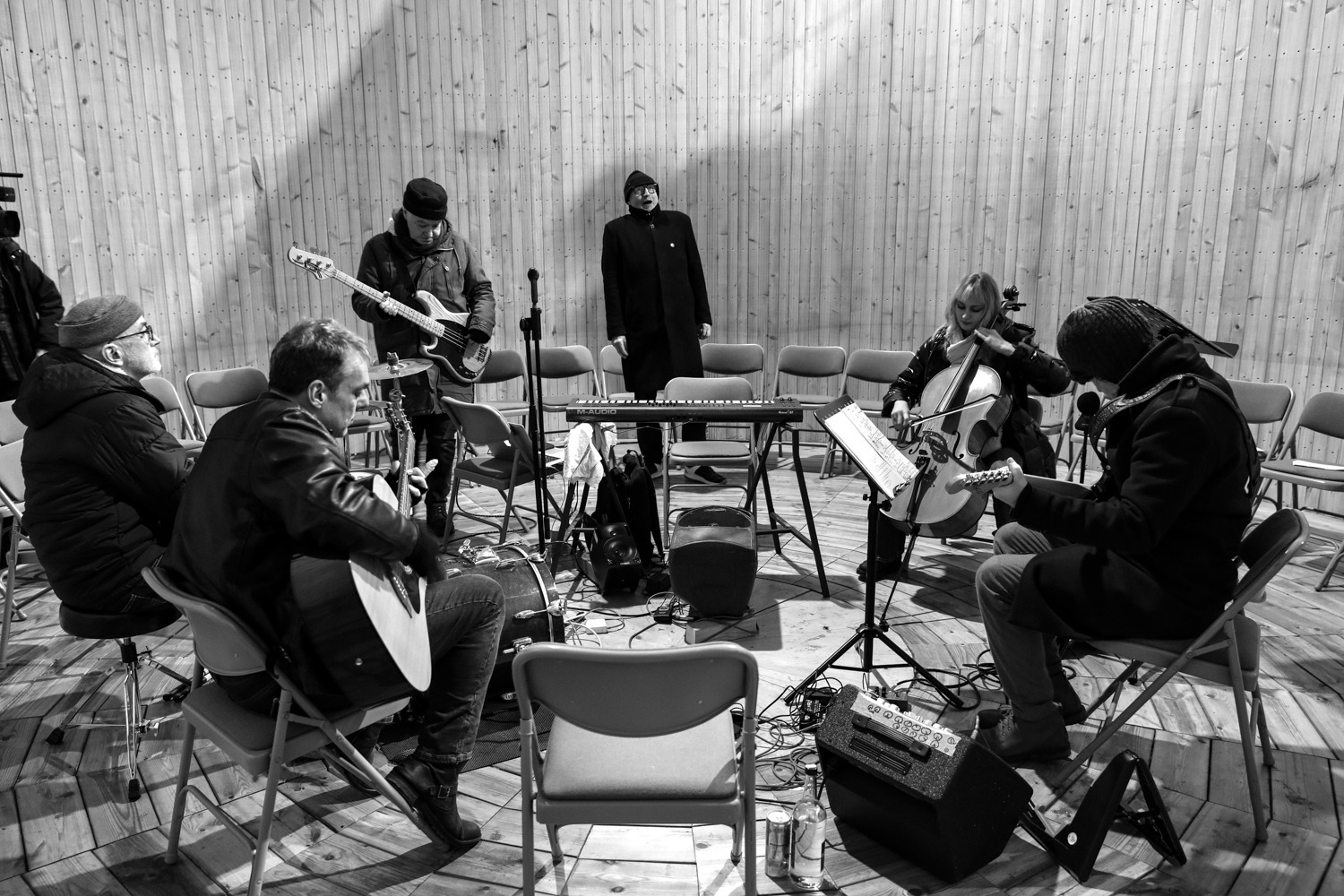
A performance within the Revelator. [Chris Leslie for The Drouth]
Our Wall Of Death is called the Revelator. It is a nomadic art space which will be used to create experimental and community-based artworks and performances it will be used as an art school, a cinema, a lecture theatre a performance space, an arts and craft workshop where traditional skills are taught such as Fairground sign writing and woodcarving. Uniquely, it is a celebration of both the traditional and the experimental. The reason we are able to do this is because we are free of external demands, free of corporate pressure. It is not about making money it is all about exchanging ideas and bringing people together, creating new audiences and exposing art to disparate groups and communities. The intention behind this is also to introduce new audiences to the Wall Of Death performance. I am aware that people who go to see a Wall of Death are from quite specific groups who may have an interest in motorbikes or fairgrounds or steam rallies. My quest is to bring audiences from all different walks of life to appreciate this art form.
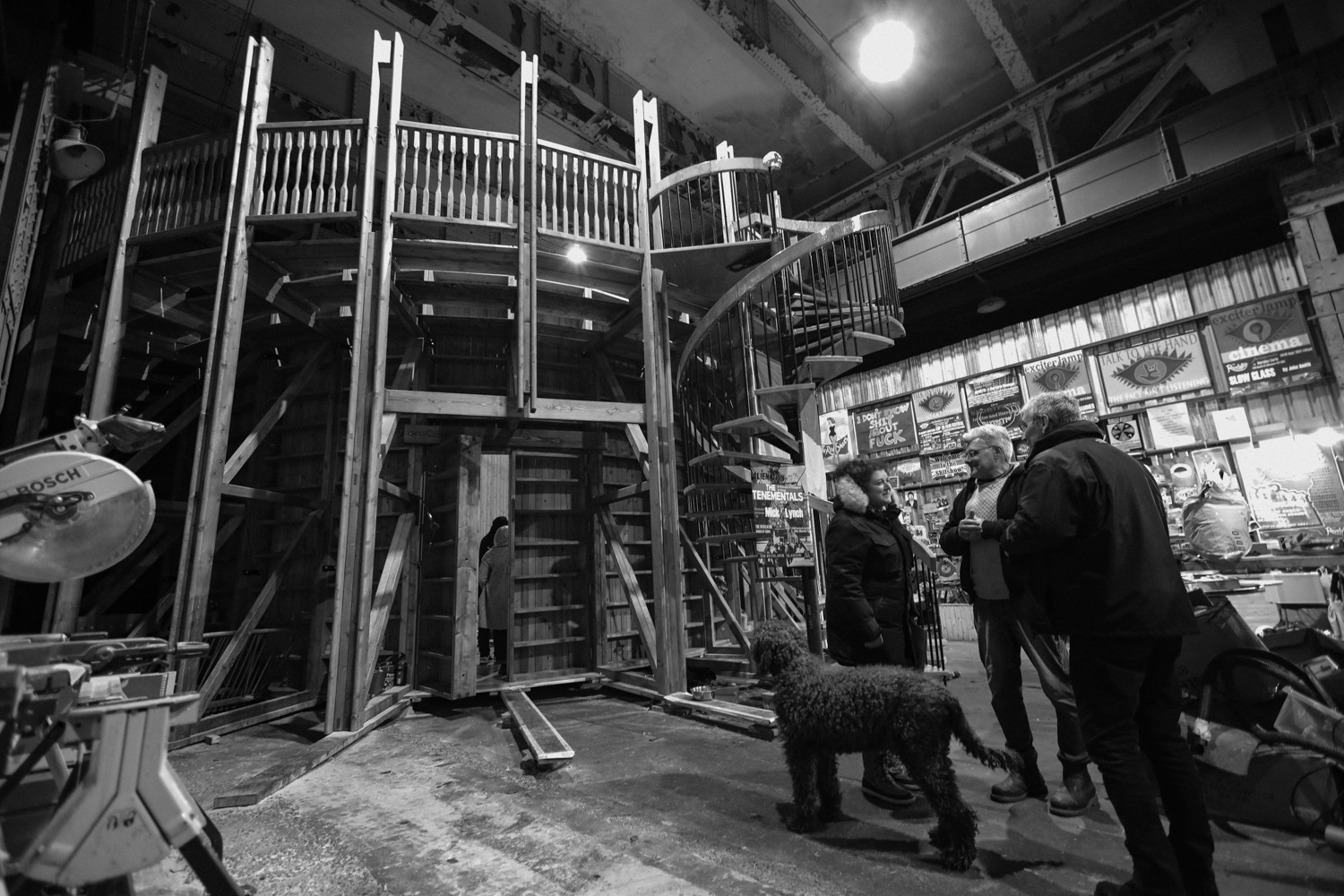
The Revelator with its spiral staircase and viewing gallery. [Chris Leslie for The Drouth]
The Revelator has come to represent a radical way of making things happen, reconnecting us with how things used to be done. We have only managed to create this magical project by working under the radar without asking permission or seeking funding from bodies which would enforce prohibitive restrictions on what we are trying to do. This has given us the freedom of expression that is unfettered from market forces and pressures from the corporate world. Any money generated from events and happenings in the space will be plowed straight back in. On high days and holidays we plan to put on traditional Wall Of Death performances. All the riders in the world are welcome to come and perform. The Wall Of Death community maybe quite small in numbers but it has a very long reach.
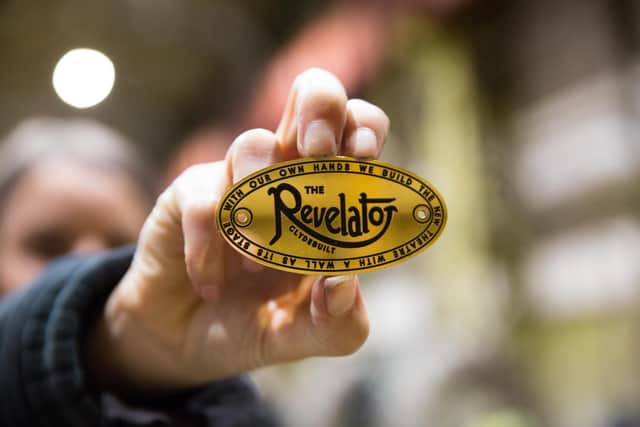
"With our hands we built the new theater with a wall as its stage" - the Revelator motto. [Robert Perry for The Scotsman]
LINKS
For the history of the Wall of Death, read our groundbreaking research on its origins.
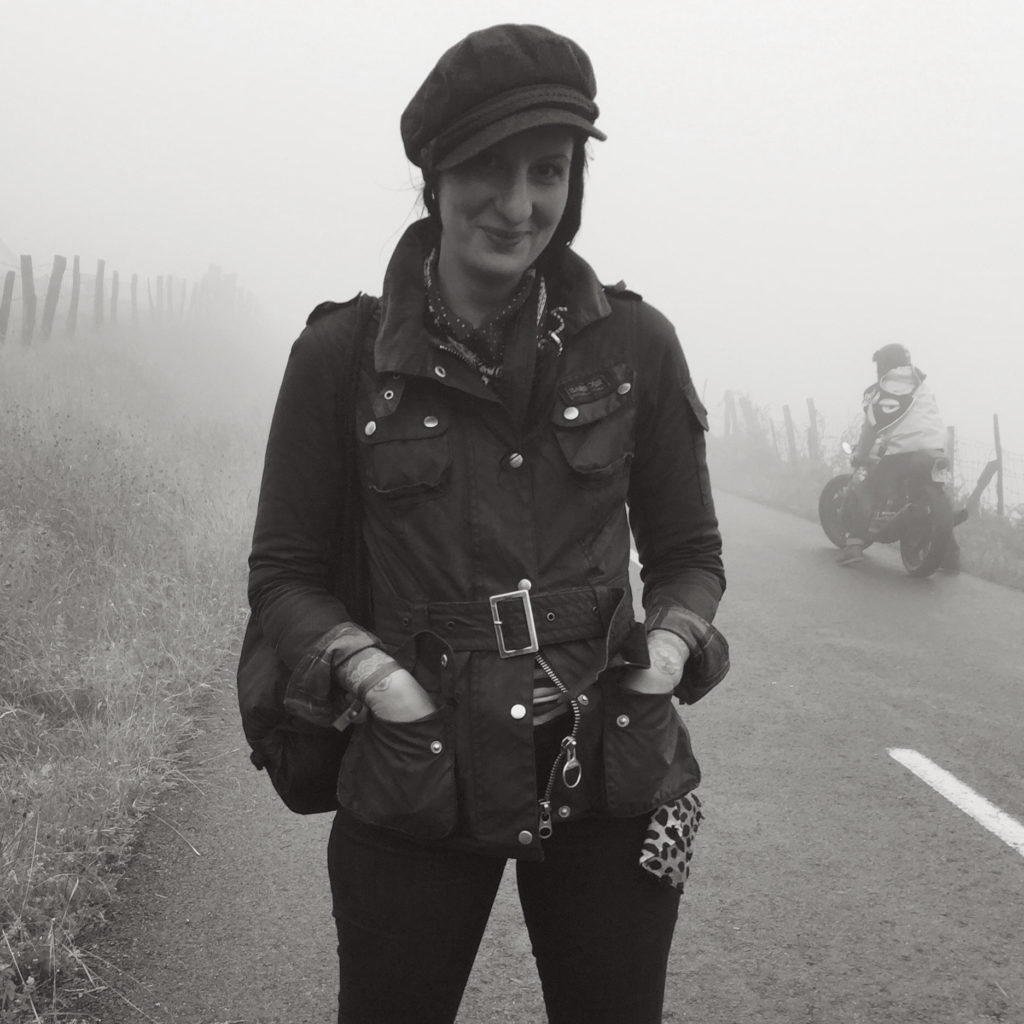
The Vintagent Selects: The Secret Cabin
https://www.youtube.com/watch?v=nAXg6xfw-YI&t=38s
The Vintagent Selects: A collection of our favorite films by artists around the world.
THE SECRET CABIN (2021)
Run Time: 27:16
A Film By: Greg Villalobos
Additional Camera: Wil Linssen, Adam Mitchinson, Clive Barber
Key Cast: Clive Barber, Noel Thom, Wil Linssen, Adam Mitchinson, Greg Villalobos
FILM MAKERS
Greg Villalobos is a veteran motorcycle film maker. His quirky adventure films include The Coast To Coast Trial (2013), The Weekend Pass (2016), The Green Lane Relay (2016), Malle Moto: The Forgotten Dakar Story (2017), and Hunt For The Wild: The Trans Euro Trail Adventure (2018).
SUMMARY
The Trans Euro Trail is an epic 50,000km dirt road route through Europe. We were set to head off from the UK to Spain to explore the pristine tracks and trails of the Pyrenees. And then Covid-19 reared its ugly head. Disaster. Or maybe not. What would a five day mini-TET adventure look like in our own back yard? And would we make it to the fabled secret cabin in the woods...
*NOTE: I know what you are going to ask... are all the trails here on the TET? Well no. The first half are routes we were scouting for possible inclusion in future updates on the TET. But the trails in Cumbria for the second half of the trip are on the TET. Go take a look at the website and start making plans for your own TET adventure today! https://transeurotrail.org/
RELATED MEDIA
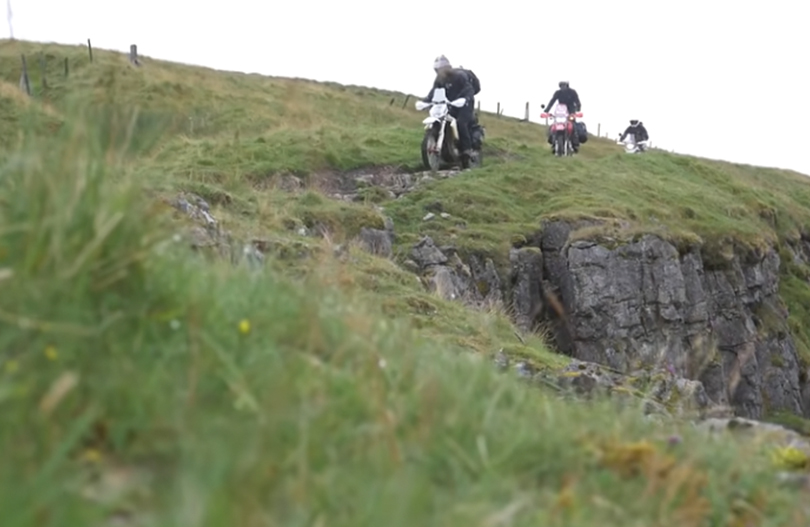
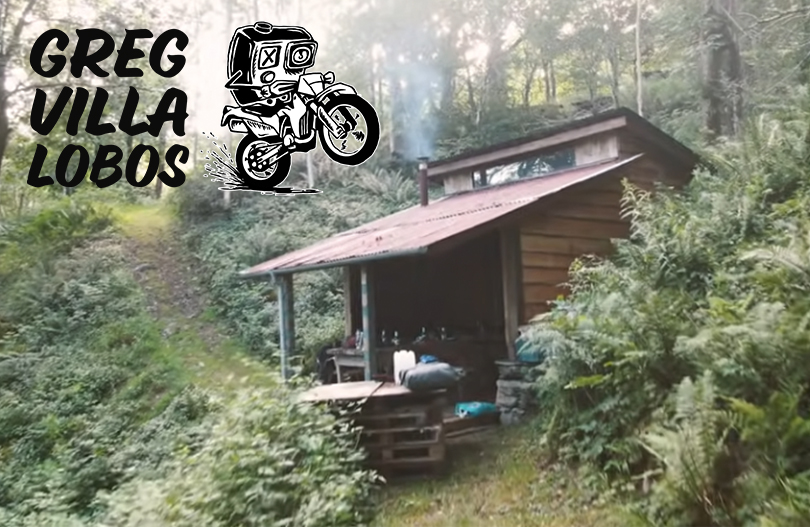
The Vintagent Classics: The Glory Stompers
https://youtu.be/adm4oOkStpQ
The Vintagent Classics: The films that inspired us.
THE GLORY STOMPERS (1967)
Run Time: 1:25:00
Producer: American International Pictures (AIP)
Director: Anthony M. Lanza
Writer: James Gordon White, John Lawrence
Key Cast: Dennis Hopper, Jody McCrea, Chris Noel
FILM MAKERS
They're On Their Way!
The Glory Stompers is one of the first in a slew of outlaw biker flicks put out between 1967 and 1971. The film was the first directed by Anthony M Lanza who was better known as an off beat low budget (B Movie) film editor, and stars Dennis Hopper in his first ever biker flick roll! The 'Biker Flick' genre itself was was kicked off and named by Roger Corman when he directed the first of it's kind, The Wild Angels starring Peter Fonda in 1966. Two dozen or so trashy exploitation 'biker flicks' were made between 1967 and 1971. Some more interesting than others, most morally objectionable, and all a piece of our motorcycle history.
SUMMARY
STRADDLE YOUR HOGS AND RIDE, MAN! The 'Black Souls' vs the 'Stompers' in the deadliest gang war ever waged!
After a standoff between two biker gangs in California, members of the Black Souls, led by the vicious and unstable Chino (Dennis Hopper) ambush Darryl (Jody McCrea), leader of the Glory Stompers, and beat him severely. Thinking they've killed Darryl, the Black Souls kidnap his girlfriend (Chris Noel) to prevent her from becoming a witness against them. They decide to traffic her in Mexico and head south for the border, unaware that Darryl has recovered and is in pursuit.
RELATED MEDIA
Watch the FULL FILM on Youtube
Listen to the FILM SOUNDTRACK on Spotify
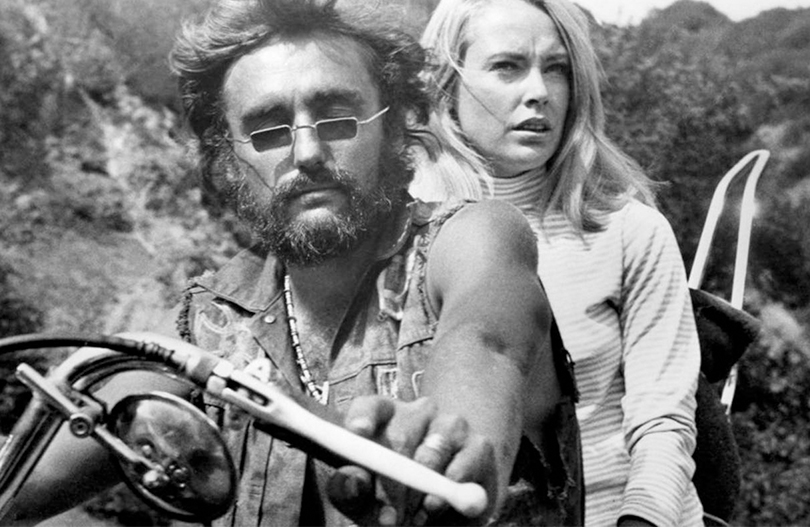
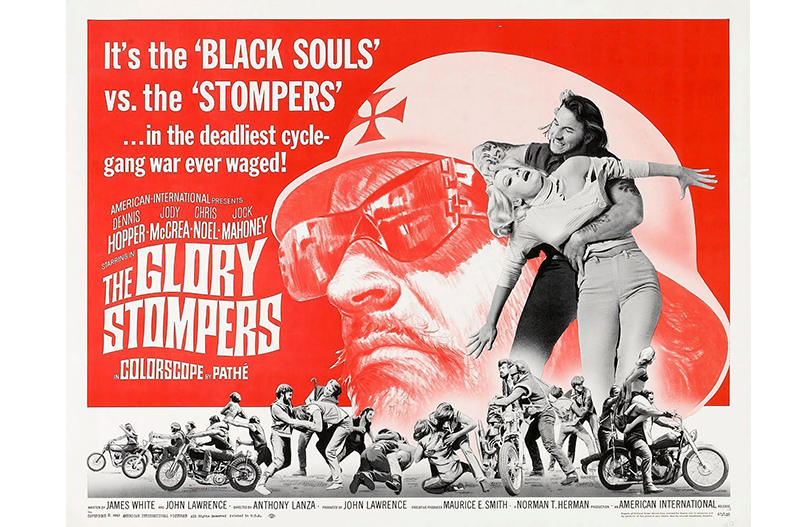
The Vintagent Selects: Pink Panther
https://www.youtube.com/watch?v=ArshtZSpRRQ
The Vintagent Selects: A collection of our favorite films by artists around the world.
PINK PANTHER (2019)
Run Time: 16:54
A Film By: Jaremey McMullin
Camera: Matthew Hyndman
Editor: Tanya Schangin
Key Cast: The Riders of the Pink Panthers
FILM MAKERS
There are 175,000 motorcycle taxi drivers in Liberia … and only 10 of them are women. They call themselves the Pink Panthers All-Girls Motorcycle Club of Liberia. Pink Panther tells KD’s story of life as a woman motorcyclist in a country and sector still dominated by men. The film looks at the successes and failures of international aid efforts to help women break into the motorcycle business. It explores the multiple and contradictory ways that gender identity and gender norms play out in post-war Liberia. KD’s love of riding and pride at being one of the first women to make it as a cyclist shine through but might not be enough to keep her in the motorbike hustle.
LIBERIA: LEGACIES OF PEACE short film series: Pink Panther is one of five films that comprise a documentary short series, 'Liberia: Legacies of Peace.' The series, funded by the Scottish Funding Council's ODA Global Challenges Research Fund, looks at the everyday challenges and opportunities of peacebuilding in post-war Liberia.
SUMMARY
"Because I'm just interested in what men can do I can do the same also. That's my policy. That's my motto."
This was Kadiatu Bah's first answer to my question about why she had decided to become a motorcycle taxi driver. Motorcycle taxis appeared in Liberia shortly after the war ended. The business started when former combatants from the war used their disarmament payments to invest in motorcycles to ferry passengers along roads that are frequently impassable by car, especially during the rainy season. Given its origins, motorcycling is at the forefront of war-to-peace transition. It's where young people are engaged in the tough work of re-building lives and livelihoods. It's one of the few sectors in Liberia where young people can survive and thrive, but it's a tough, competitive sector almost entirely dominated by men. Liberia's Pink Panthers are trying to change that. In this film, I wanted to capture the hope and promise of that change but also show how hard change can be to achieve, even in a country that considers itself at the forefront of 'gender mainstreaming' efforts. The film documents the successes and failures, big and small, of development aid efforts to help the Pink Panthers. I come from the academic world and it's full of stories of aid assistance failures. It's rare to find work on post-war transition that tells stories of joy, and this film is first and foremost about the pride and happiness that KD gets from being a motorcycle taxi driver. She said the assistance that the women received, notwithstanding various failures, was instrumental to supporting women riders at a critical time. She participated in the film because she hopes that it will convince people to provide more assistance to women riders so that women can move from the street into activities of self-support.
RELATED MEDIA
Read Jaremey McMullin's research paper - Hustling, cycling, peacebuilding: Narrating postwar reintegration through livelihood in Liberia
Watch Jaremey McMullin's companion short film - Best Man Corner
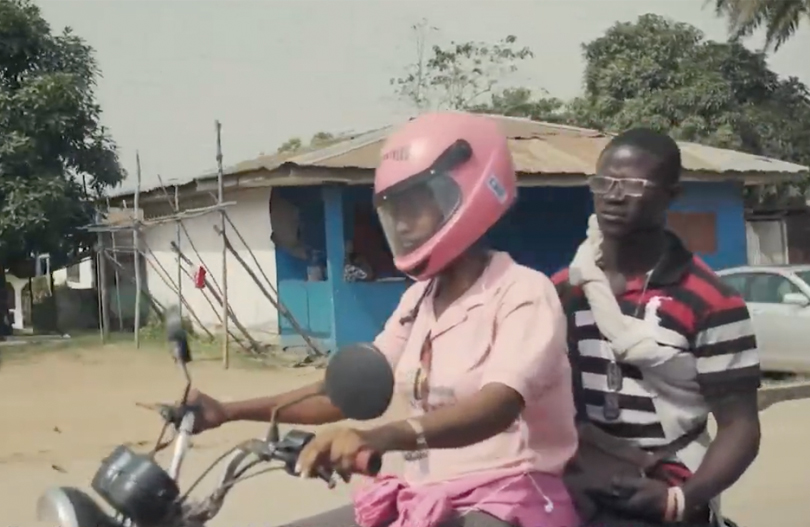
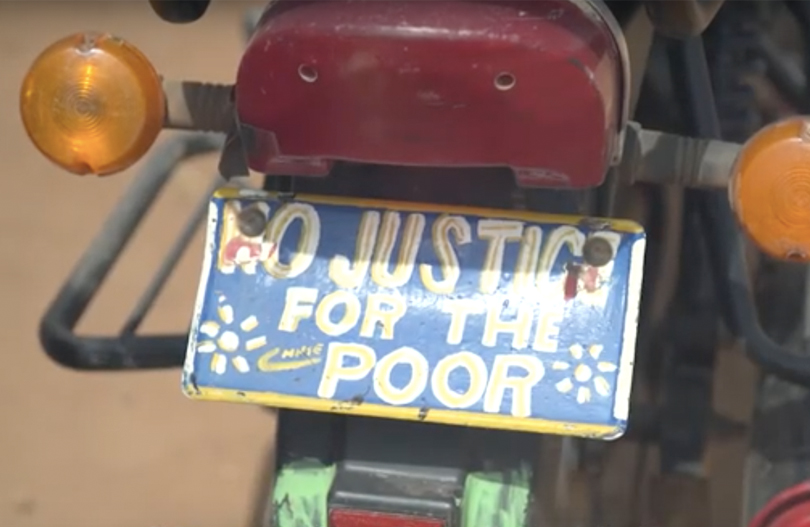
The Vintagent Selects: Best Man Corner
https://www.youtube.com/watch?v=nMCfoWDnPPM
The Vintagent Selects: A collection of our favorite films by artists around the world.
BEST MAN CORNER (2019)
Run Time: 19:02
A Film By: Jaremey McMullin
Camera: Matthew Hyndman
Editor: Tanya Schangin
Key Cast: The Riders of Best Man Corner
FILM MAKERS
Over 175,000 motorcycle taxi drivers operate across Liberia. Most of them are either former child soldiers or conflict-affected youth who lost out on economic and educational opportunities because of the war. Best Man Corner profiles the young riders of one of Monrovia’s motorcycle taxi ranks, exploring how the ‘motorbike hustle’ is a means of survival but also a form of building peace.
LIBERIA: LEGACIES OF PEACE short film series: Best Man Corner is one of five films that comprise a documentary short series, 'Liberia: Legacies of Peace.' The series, funded by the Scottish Funding Council's ODA Global Challenges Research Fund, looks at the everyday challenges and opportunities of peace building in post-war Liberia.
SUMMARY
“You can never get what you want in life if you’re not able to hustle.”
Best Man Corner opens with these words from Edwin, a long-time motorcycle taxi driver and former child soldier. His experiences in the ‘motorbike hustle’ contrast the opportunities and constraints of post-war life in Liberia. If peace building is always unfinished, then to whom does the unfinished work of building peace fall? Best Man Corner ethnographically situates answers to this question at a busy motorcycle taxi rank in central Monrovia. Ex-combatant and conflict-affected youth make up the vast majority of Liberia’s 175,000 motorcycle taxi drivers. Motorcycling emerged after Liberia’s civil war as a critical economic sector. It provides cyclists with economic livelihood opportunities and constitutes a space of socio-political youth mobilization. Motorcycling offers a unique vantage point to understand the long-term post-war challenges facing youth and the multiple roles that young people play after war. The motorbike riders at Best Man Corner ride to survive, but also make clear that, through motorcycling, they establish themselves as active peacebuilding subjects, enacting their own ideas to counter the insecurity and marginalization of post-war life. Their experiences raise critical questions: Where is peace built? Who builds peace, and whose peacebuilding contributions are seen and recognized? How is peacebuilding understood and evaluated? And, how does film make otherwise hidden aspects of the research process visible? These questions underscore how the long-term trajectories of youth are too often neglected in academic and policy approaches to post-war transition.
RELATED MEDIA
Motorcycling As Peacebuilding - Center for Peace and Conflict Studies
Watch Jaremey McMullin's companion short film - Pink Panther
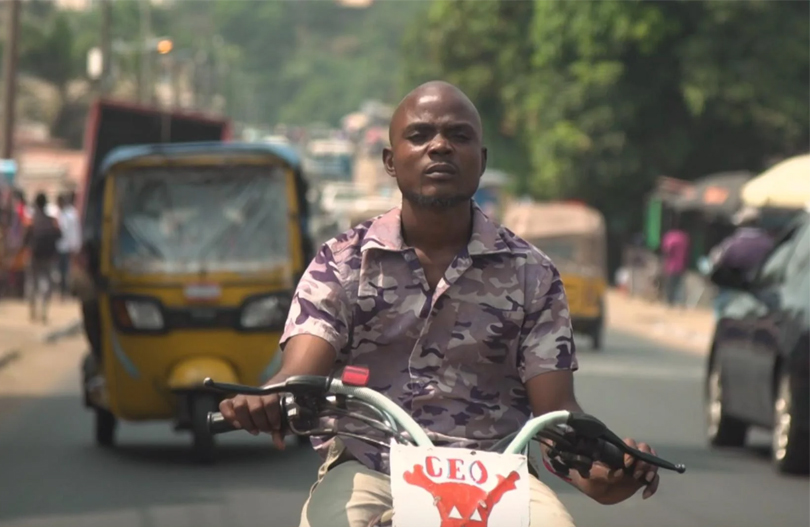
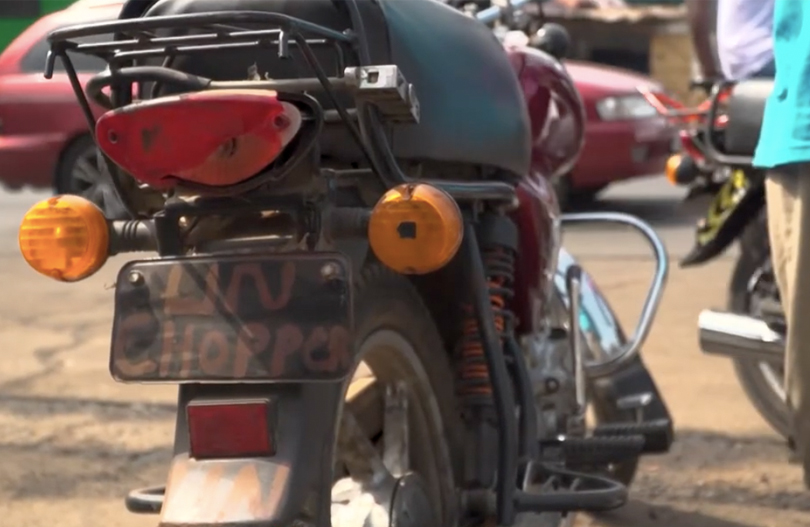
The Vintagent Classics: Fast Company
https://vimeo.com/815111185
The Vintagent Classics: The films that inspired us.
FAST COMPANY (1977)
Run Time: 12:20
Producer: New Decade, John Wolstenholme
A Film By: Stanley C. Marks
Editor: Bill Green
Key Cast: Chris Sandford (narrator), Barry Sheene, John Reed aka Uncle Bunt
FILM MAKERS
Fast Company is a short film released as a B movie in British cinemas in 1977 (not to be confused with the 1979 David Cronenberg race car film of the same name), and is taken from an original 1977 copy of the complete movie on Super 8mm cine film. The film covers all aspects of the changing motorcycle scene in Britain at that time. This rare film finds itself on The Vintagent thanks to John Reed (aka Uncle Bunt) who appears in the film.
SUMMARY
Starting with the biker gang's ride out to the sea front, it then goes on to the motorcycle show with the guy of a thousand badges and customs and classics gleaming in the sun! It then features stunt riding from the White Helmets. The Mercury Despatch motorcycle couriers in London are shown hard at work and the businessman's daily commute into the capital on his moped. There is road race action with Barry Sheene and company from Mallory Park and the Custom/Chopper scene with some Hell's Angels visiting Uncle Bunts on a trike and the guys at Bunts working on various customs and choppers. More racing action later on in the film with scrambling and sidecar motocross & sidecar road racing and then it finishes off with the biker gang back on the road again and the titles.
*Some loss of sound occurs around the Uncle Bunt section and some other places due to wear on the original super 8 reel this was taken from. If you can find us a better copy... We want to see it!
RELATED MEDIA
Watch the FULL FILM on Cine Meccanica youtube
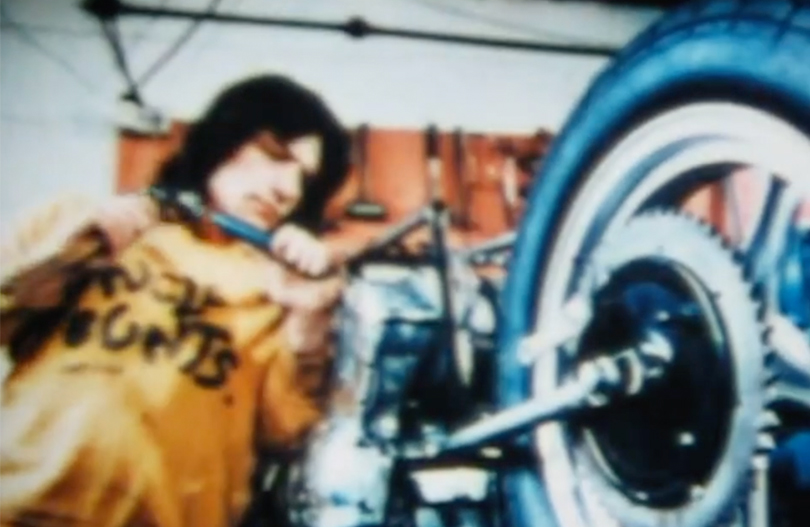
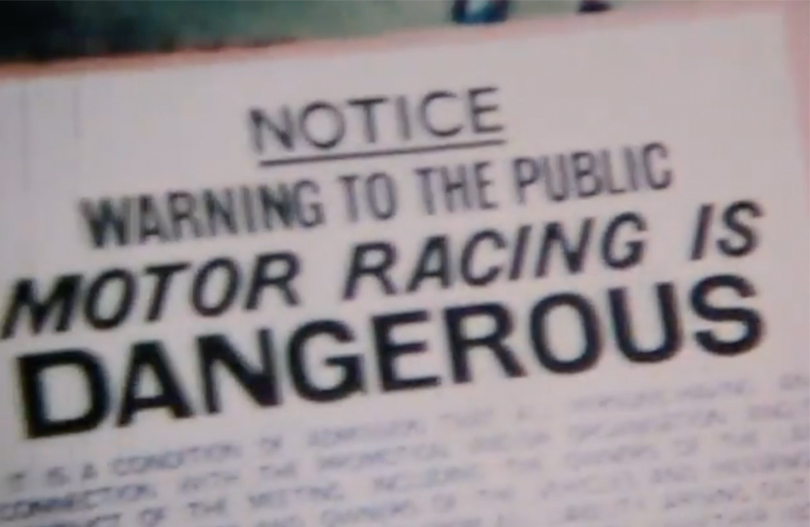
The Vintagent Trailers: Rodeo
https://www.youtube.com/watch?v=F5iXef4071U
The Vintagent Trailers: A preview of our favorite feature films out there.
RODEO (2022)
Run Time: 1:45:00
Producer: CG Cinéma
A Film By: Lola Quivoron
Writer: Antonia Buresi, Lola Quivoron
Key Cast: Julie Ledru, Yannis Lafki, Antonia Buresi
FILM MAKERS
Rodeo (French: Rodéo) is a 2022 premiered in the Un Certain Regard program of the 2022 Cannes Film Festival, where it won the Coup de Coeur prize and was shortlisted for the Queer Palm. It went on to win the Golden Puffin Award at the 2022 Reykjavík International Film Festival. At the Seville European Film Festival, the film won the Cinephiles of the Future award and Ledru was co-winner with Zar Amir Ebrahimi of the award for Best Actress. The film won the Audience Award for the Altered States program at the 2022 Vancouver International Film Festival.
SUMMARY
Julia, a young woman living in social housing who has a poor relationship with her mother; passionate about the sport of motocross, she tries to gain the opportunity to participate in the sport by posing as a buyer on shopping websites so that she can take bikes out for test rides. As she becomes drawn deeper into the urban motocross scene, however, she begins to participate in a motorcycle theft ring.
Note: Most of the actors are non-professional, including of the main character, Julia, played by Julie Ledru. Writer/director Lola Quivoron has been immersed in the urban rodeo world for a while and had realized that all riders were men. She had been looking for some time for her lead, and stumbled onto the Inconnue_du_95 account on Instagram. When she met her, she realized that her life was very much like her character's, so much that some details of her life ended up in the movie.
RELATED MEDIA
In NYC? You can see the film at the beautiful Roxy Cinema on April 15th.
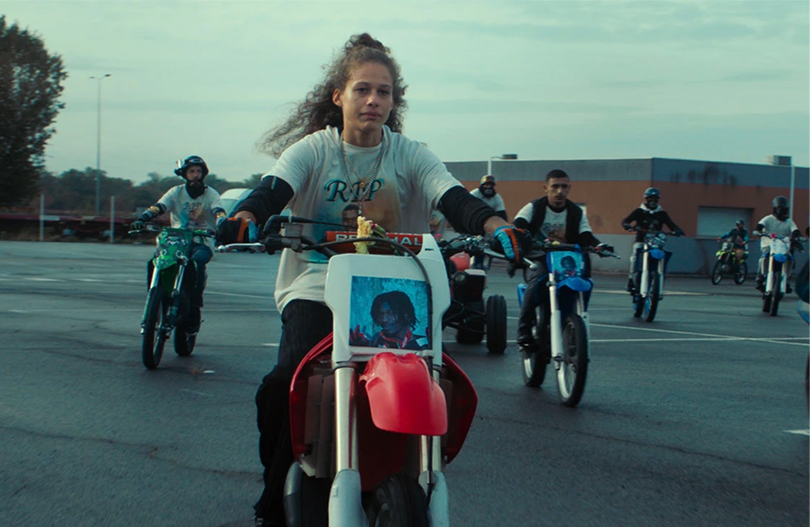
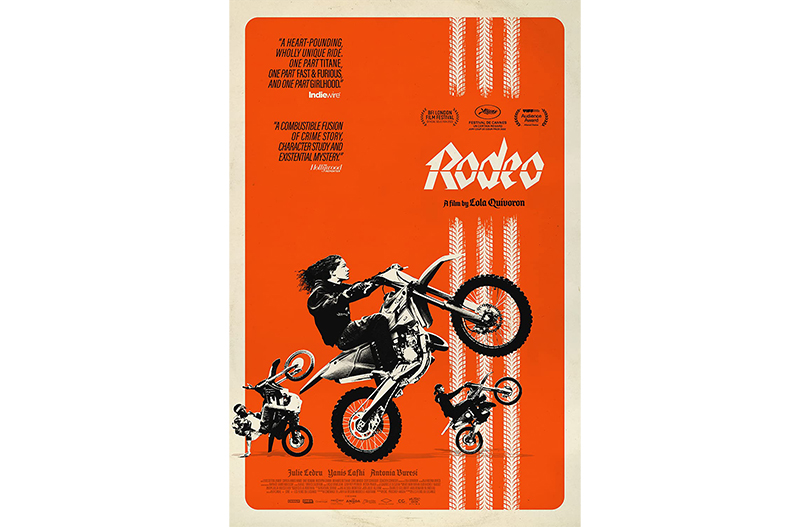
The Vintagent Trailers: The Artist And The Wall Of Death
https://www.youtube.com/watch?v=U3hecXIJmFU
The Vintagent Trailers: A preview of our favorite feature films out there.
THE ARTIST AND THE WALL OF DEATH (2023)
Run Time: 1:26:00
Producer: John Kelleher, Grant Keir,
Director: Maurice O'Brien
Key Cast: Stephen Skrynka
FILM MAKERS
Maurice O'Brien has been directing as well as producing critically-acclaimed, award-winning films for
15 years. His work has screened at film festivals around the world and as well as working with the
BBC for over a decade he has made films for Screen Ireland, Guardian Documentaries, RTE,
Screen Scotland, and Channel 4/Discovery. O'Brien is also one of the creative minds behind Dazzled By Daylight, The Artist and the Wall of Death, Hey Ronnie Reagan and Buffalo Dreams
SUMMARY
The unlikely story of a Glaswegian visual artist, Stephen Skrynka, and his dangerous life-long obsession with riding the ‘Wall of Death’. Stephen dreams of transforming the traditional fairground motorbike attraction into an art form. But he underestimates the difficulties of combining his artistic vision with the commercial instincts of his Irish ‘Petrolhead’ collaborators, Connie Kiernan and Michael Donohoe, the original true-life inspiration for the cherished Irish film, ‘Eat the Peach’.
After a devastating falling out, Stephen rashly decides to hand-build his own Wall, out of recycled wood, in a disused factory on the River Clyde in Glasgow. In the midst of the Pandemic, facing a crisis of money and self-belief, Stephen’s dreams seem doomed. But salvation arrives in the shape of unexpected comradeship, anonymous donations and the kindness of strangers. Stephen builds his Wall. But can he ride it?
Worldwide release coming soon. Stay tuned!
RELATED MEDIA
Read The Guardian interview: Stephen Skrynka: 'This is not some Jackass stunt'
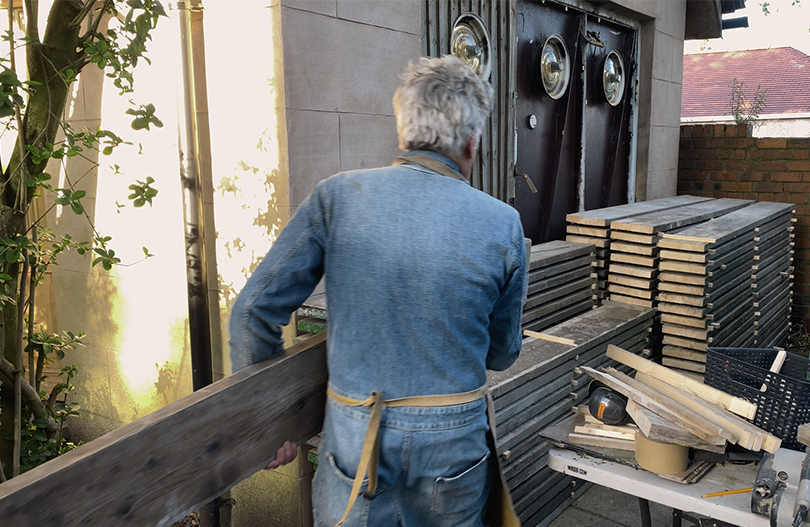
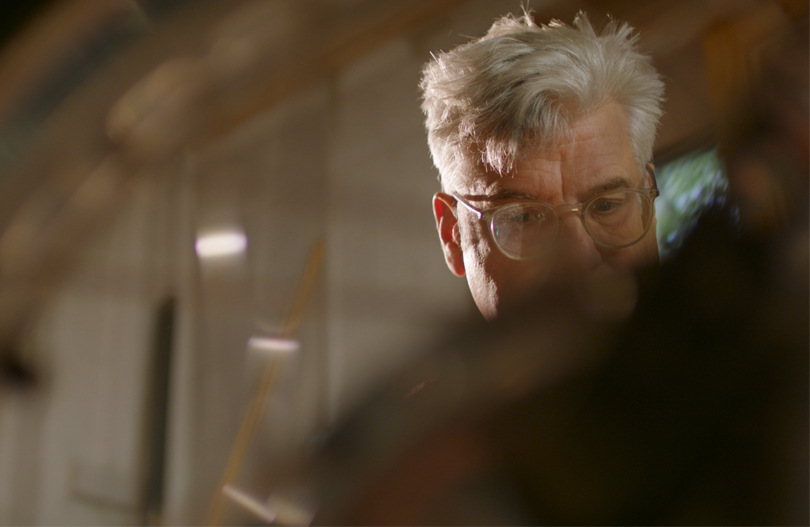
The Vintagent Classics: C.C & Company
https://www.youtube.com/watch?v=A3E2qLY9Rzw
The Vintagent Classics: The films that inspired us.
C.C & COMPANY (1970)
Run Time: 1:34:00
Producer: Namanco Productions
Director: Seymour Robbie
Writer: Roger Smith
Key Cast: Joe Namath, Ann-Margret, William Smith
FILM MAKERS
C.C. and Company is a 1970 American biker flick directed by Seymour Robbie. It starred Joe Namath as biker C.C. Ryder, Ann-Margret as fashion journalist Ann, and William Smith as Moon, the leader of the fictitious outlaw biker club the "Heads Company". The film also features singer Wayne Cochran and his band The C.C. Riders. At the time, reviews were mostly negative. It was described by The New York Times reviewer Vincent Canby as "the picture to name when someone asks you to recommend 'a good bad movie.'"
SUMMARY
C.C. Ryder falls in with a biker gang in the desert, and then rescues Ann from trouble with the same gang. There next occurs a motocross race tied in with a fashion shoot. The Heads disrupt the event, but C.C. Ryder enters the race to gain Ann's favor. This puts him in conflict with Moon. When Ryder wins the race and leaves with his award money the gang kidnaps Ann, and Ryder must ride back to save her.
RELATED MEDIA
Read more at CINE MECCANICA
Watch the FULL FILM for free on Tubi
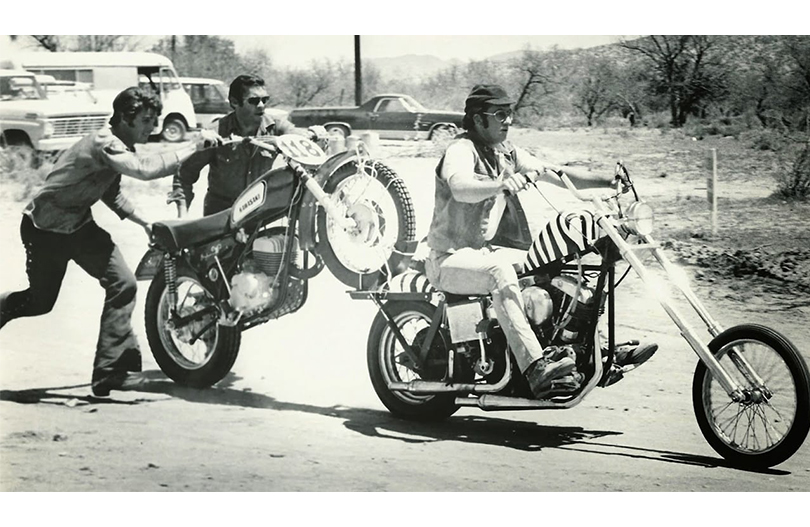
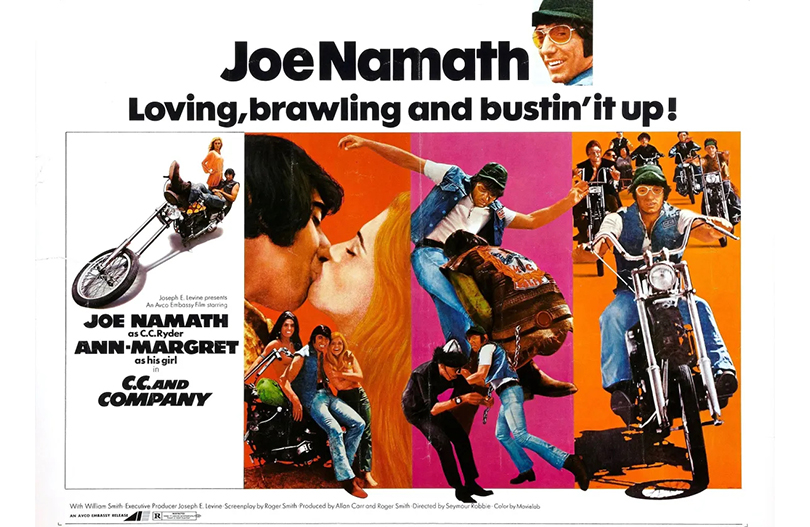
The Vintagent Trailers Premier: The Passenger
https://vimeo.com/804908368
The Vintagent Trailers: A preview of our favorite feature films out there.
THE PASSENGER (TBA, Summer 2023)
Run Time: 22:10
Producer: Brian Awitan, Beth Miller, Michael Barnett, Jeff Elstone, Gentry Dayton
Director: Jeff Elstone
Writer: Jeff Elstone
Director of Photography: Keith J Leman
Key Cast: Gentry Dayton, Wil Thomas (see his feature on The Vintagent here), Stephanie Sasso
FILM MAKERS
Jeff’s journey as a director began in childhood creating no budget adventure films with neighborhood friends on his parents’ VHS camcorder. He attended Temple University’s Film and Media Arts program in Philadelphia and directed his first short, Mother Divine, at the age of 23. The film was shot at one of the city’s most enigmatic and iconic landmarks, and was scored by esteemed Israeli composer Ady Cohen. After graduating in 2003, Jeff relocated to NYC where he worked as an assistant for photographer/director Steven Klein and later developed a notable career of his own as an international fashion and portrait photographer. The Passenger represents a return to his primary passion for narrative storytelling that also integrates a refined and visceral style honed over years behind the camera.
SUMMARY
To say anything of 2020 would inevitably sound like an understatement.
In the midst of a worldwide shutdown with no end in sight, my longtime best friend Gentry Dayton and I, along with producer Brian Awitan, sought to make the most of this unprecedented pause, at a time when grief hung heavy in the ether. What began as a pandemic project rapidly expanded into a universal meditation on loss, despair, and transformation.
While many stories rooted in motorcycle culture have predictably tired macho themes, this film is a psycho-spiritual walkabout with a tour through haunted terrain into a cocoon leading to an unexpected rebirth. The Passenger invokes the foreign art house films of the 70s, while simultaneously celebrating the classic Americana of Easy Rider that highlights the raw, fragile texture of mental health with a marked gritty spirituality, where the essence of friendship is defined and nature is personified as both a merciless and healing force.
The film also features an original score by legendary underground artist Jarboe and her creative partner Kris Force, whose previous work on 'The Path' garnered a "Best Composition" Award at the Bilbao International Game Awards. Thor Harris, a member of Swans, also contributed his eminent talents to the soundtrack and, curiously, I have a Swans tattoo on my left arm - which makes for a truly synchronistic moment in time.
RELATED MEDIA
Read The Vintagent's interview with the filmmakers and producers.
Jeff Elstone website: behind the scenes footage
